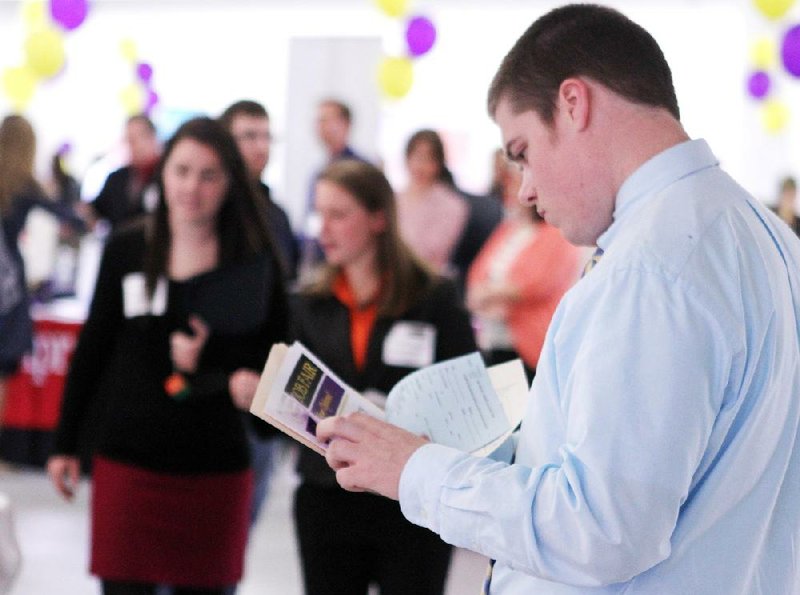LITTLE ROCK — More than one in 10 borrowers defaulted on their federal student loans, intensifying concern about a generation hobbled by $1 trillion in debt and the role of colleges in jacking up costs.
The default rate, for the first three years that students are required to make payments, was 13.4 percent, with for-profit colleges reporting the worst results, the U.S. Education Department said Friday.
The Education Department has revamped the way it reports student-loan defaults, which the government said had reached the highest level in 14 years. Previously, the agency reported the rate only for the first two years payments are required. Congress demanded a more comprehensive measure because of concern that colleges counsel students to defer payments to make default rates appear low.
“Default rates are the tip of the iceberg of borrower distress,” said Pauline Abernathy, vice president of The Institute for College Access & Success, a nonprofit based in Oakland, Calif.
The data follow complaints that commission driven debt collectors the government hires aren’t telling students about affordable options to repay their debt, especially a plan that lets them make payments tied to their incomes. Students have borrowed $1 trillion to pay for higher education, surpassing credit-card debt.
Congress also is examining the often deceptive letters that college financial-aid offices send to admitted students that play down the cost of attendance by making government loans seem like grants. President Barack Obama’s administration, as well as Republicans and Democrats in Congress, are calling for more disclosure about college costs and student outcomes.
On the stump, Obama has touted an executive order that eases the process for applying for a loan program that lets students make lower payments tied to income - easing the burden and making default less likely.
Republican challenger Mitt Romney said that initiative encourages students to take on more debt. Romney advocates cutting education regulation and encouraging colleges to become more efficient, lowering costs partly through the use of online instruction.
The government tracks default data to protect taxpayers and keep students from attending programs that don’t prepare them for employment.
“We continue to be concerned about default rates and want to ensure that all borrowers have the tools to manage their debt,” Education Secretary Arne Duncan said in a statement. “In addition to helping borrowers, we will also hold schools accountable for ensuring their students are not saddled with unmanageable student loan debt.”
Under the new three-year measure, colleges with default rates of 30 percent or more for three consecutive years risk losing eligibility for federal financial aid. Schools also can be barred from the program if the rate balloons to 40 percent in a single year. The sanctions don’t take effect until results are released in 2014.
Friday’s report covers the three years through Sept. 30, 2011. For all colleges, the 13.4 percent rate exceeded the two year rate of 9.1 percent - the worst in 14 years - and up from 8.8 percent a year earlier.
By the new three-year yardstick, the default rate at for-profit colleges was 22.7 percent. Based on the two year period, they reported a 12.9 percent default rate.
Under the three-year-period, public colleges reported an 11 percent rate while private nonprofit schools had a rate of 7.5 percent.
Some for-profit colleges encourage students to defer payments in their early years, in an effort to keep down default rates that could jeopardize their federal funding, according to a report by the Senate Committee on Health, Education, Labor and Pensions released in July.
The report accused for profits of using the tactic to manipulate their default rates. It singled out the role of SLM Corp., the largest U.S. student-loan company commonly known as Sallie Mae. A subsidiary, General Revenue Corp., counsels for-profit colleges on keeping down default rates. University of Phoenix, owned by Apollo Group Inc., is a customer, according to the congressional report.
Apollo and Sallie Mae use loan forbearance as “a last resort,” Patricia Nash Christel, a spokesman for Sallie Mae, and Richard Castellano, an Apollo spokesman, said in separate e-mails.
Apollo provides financial incentives for those administering its loans to get students into repayment plans, rather than defer payments, Castellano said.
For-profit colleges cater to working adults and first generation college students, Steve Gunderson, president of the Washington-based Association of Private Sector Colleges and Universities, said in a statement about the default rates. The industry has said the demographics of its students account for its schools’ higher default rates.
Gunderson called on the Department of Education to improve its loan-collection programs and eliminate penalties and called on Congress to give schools the authority to limit loans.
Member schools will continue to provide their students with financial literacy and debt-repayment counseling, he said.
“It is only by the entire higher-education community working together with elected officials and policy makers that we will help millions of Americans effectively manage their student loan debt,” he said.
The new data suggest that student-loan debt may damage students’ economic prospects for many years, said Stephen Rose, a labor economist at Georgetown University.
“The more people having trouble today means that more people will have trouble in the future because they are starting out building up a larger balance, and they’re not paying them off,” Rose said in a telephone interview.
Information for this article was contributed by Justin Pope of The Associated Press.
Front Section, Pages 1 on 09/29/2012

